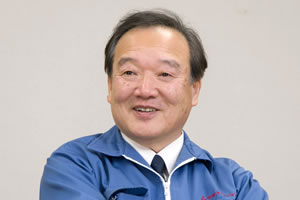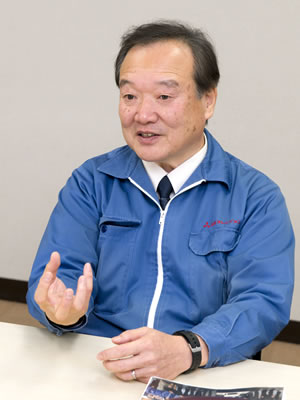Absolute precision through cleanliness management and the pursuit of zero tolerance
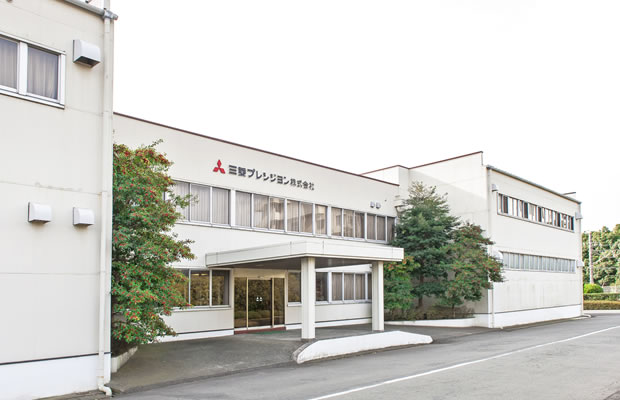
High reliability is the absolute requisite for equipment installed onboard satellites, as no one on the ground can easily go into space to repair it.
JAXA staff visited the Mitsubishi Precision’s clean room where bearings, the key parts of an aerospace-quality reaction wheel, are assembled. At Mitsubishi Precision, bearings purchased from a manufacturer are first disassembled and cleaned, and then assembled while confirming their properties to enhance the reliability of the component.
The long-standing reliability of such bearings over one or two decades is due to two major factors. One is the work to remove dirt, known as contamination. The smallest balls (about 1 mm in diameter) in ball bearings used for satellites cannot function properly when micron-sized particles of dirt adhere to them.
The other key factor is the amount of lubricant applied to the bearings. Excessive lubricant increases the rolling resistance of the bearings, while insufficient lubricant results in friction that causes the bearings to deteriorate.
Accordingly, no dirt in the well-controlled environment and application of the precise amount of oil are critical for ensuring the reliability of the parts.
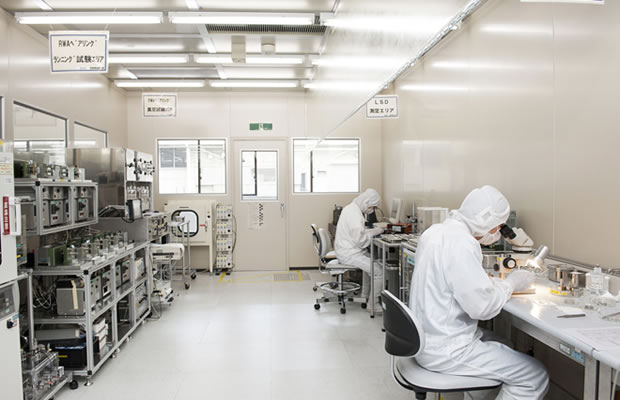
Clean Room Class 100. Employees focusing on their detailed work.

The precise amount of oil at the microliter level is manually injected into a ball of a ball bearing by using an ultrafine syringe-like instrument (micro syringe) as viewed through a telescope.
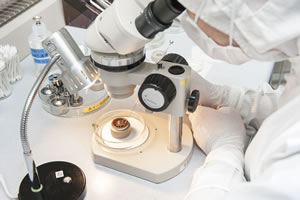

The bearing being assembled is examined to check its placement parallel to the surface, on which a gyroscope is installed, with its axis vertical. The strict standard only allows micron-level tolerance.
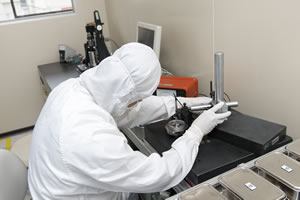
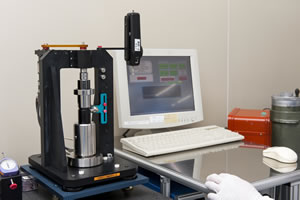
Once assembly is completed, the bearing is examined to confirm that there is no assembly failure and no dirt inside, and that the appropriate amount of lubricant is applied by measuring the bearing’s resistance while rotated.
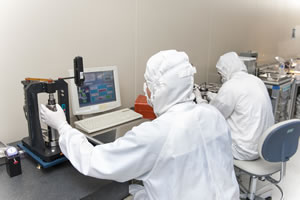
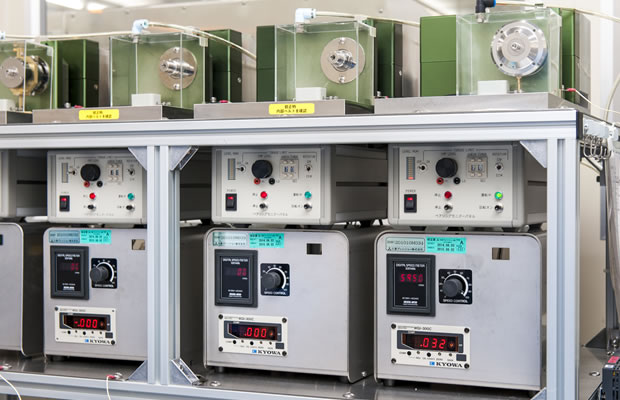
Units for checking the condition of assembled bearings by a running-in operation with a given number of rotations for a certain period of time. Among them is a unit for rotating a bearing in the atmosphere and one for rotating a bearing under a vacuum.

The station where the cleaning solution for cleaning parts is prepared. The cleaning solution after being filtered and a specific glass implement made of 100% quartz that generates no dirt are used here.
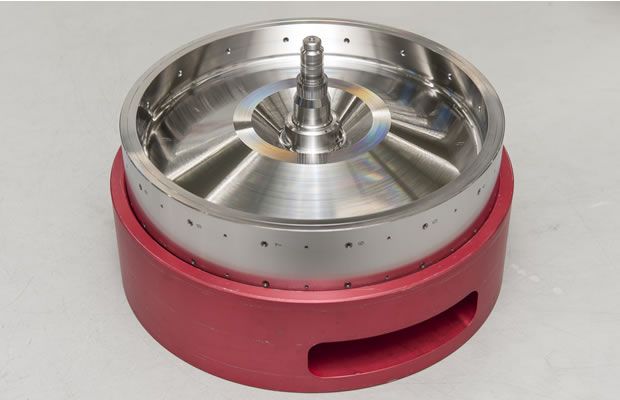
A single body of a 6-kg rotor actually used for a reaction wheel. The mirror finish of its surface prevents dirt from being generated and adhering to the bearing. The hole on its side is a screw hole used when fine tuning the rotor’s balance. The bearing supporting the top and bottom of the shaft in the center changes a satellite’s attitude by changing the rotor’s rotational speed.
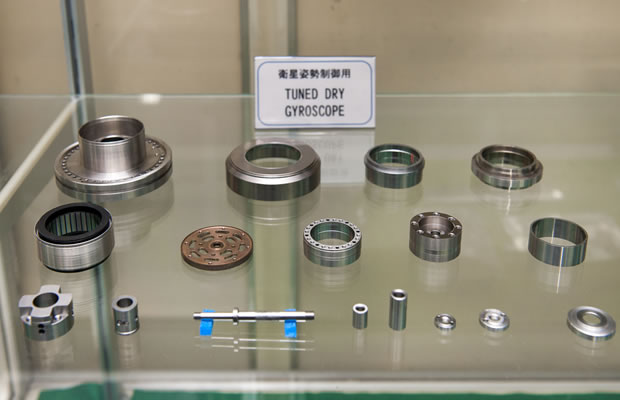
Parts used for the satellite attitude control unit. Tiny bearings are built in the parts.
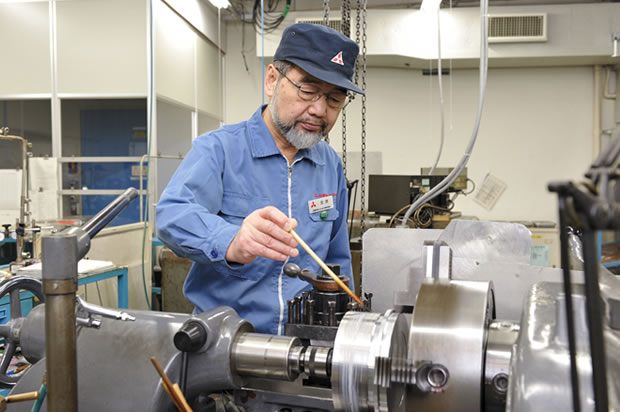
Mr. Masahiro Kawahara, honored as a Contemporary Master Craftsman by Japan’s Ministry of Health, Labor, and Welfare, turning the parts of the reaction wheel. Excellent craftsmanship by employees as developed through years of experience, including the post-process measurement setting in light of the thermal expansion of materials and the installation method in light of deformation, bolsters the company’s aerospace quality.
Mitsubishi Precision Co., Ltd.
| HQ Location | Koto Ward, Tokyo |
|---|---|
| Year of Establishment | 1962 |
| Main Production Site | Kamakura Plant |
| Main Products | Electronic precision instrument (e.g. gyro- and radio wave-applied equipment), space instrument (e.g. satellite attitude reference unit, attitude control unit, rocket guidance unit), simulation system (e.g. simulator, imaging system), and traffic control (e.g. parking system) |
| Space Experiments to Date | Data, drive, and power control units of 145 satellites, including the Advanced Land Observing Satellite “DAICHI” (ALOS) and the Global Change Observation Mission - Water "SHIZUKU" (GCOM-W) (as of January 2013), data, drive, and power control units of the Japanese Experiment Module “Kibo” on the International Space Station, drive and power control units of the H-II Transfer Vehicle “KOUNOTORI” (HTV) |
| Company Website | https://www.mpcnet.co.jp/e/ |
INTERVIEW
インタビュー
Mitsubishi Precision, Japan’s pioneering space-related equipment company, has been engaged in space development for over a half century.
The company develops 100% domestically produced reaction wheels!!
Mr. Satoshi Yasui, Director and Head of the Kamakura Plant *
(* Mr. Yasui is currently the Corporate Adviser (December 6, 2017).)
Mitsubishi Precision has a long history of space development. Starting with the attitude control unit mounted on the launch rocket of Japan’s first satellite Osumi, it has produced a large variety of space equipment for satellites, the International Space Station, and rockets. It demonstrates its presence as the only company that can produce 100% domestic large reaction wheels. The company’s history and its struggles in the development of highly reliable space equipment are discussed below.
JAXA: Could you introduce us to the history of Mitsubishi Precision?
Mitsubishi Precision was established in 1962 as a company for the design and manufacturing of attitude reference units using the flight simulators and gyroscopes of fighter planes. Today, we deal with a wide range of simulating devices for training and education in the fields of aircraft, trains, automobiles, motorcycles, and ships.
JAXA: Do you have any products with which we are familiar?
You may have seen our driving simulators that have been introduced at driver’s license schools in certain locations. The simulators are highly evaluated for helping to enhance the effects of driving lessons because these devices enable people to experience danger, such as accidents that they typically do not experience, and think about the risks of driving at night, in rain and snowfall through simulated driving. We also develop a parking system for pay parking lot management. Our strength is pay parking lots that accommodate many vehicles, such as those at shopping centers and airports. These parking lots offer users a sense of comfort with a notice board informing them of empty spaces and the parking fee prepayment machine for in-advance payment before they get into their cars, as well as issuing parking tickets at the entrance and parking fee payment at the exit. A unique example is a simulator used for laparoscopic surgery training. Our company mainly deals with four areas of business: simulation systems, aerospace, inertia, and radio wave-related systems, parking systems, and maintenance and service business.
JAXA: What is the maintenance and service business?
We not only manufacture products but also provide maintenance and after-sales service. The business includes the allocation of on-site engineers at customer locations to support customers in their operation of simulators, maintenance and the sales of supplies for simulation systems and parking systems, and the repair of installed systems at our service centers.
JAXA: How have you accumulated domestic technology used in the reaction wheels for space-related equipment?
Originally, we started with the development of reaction wheels as part of the application of our rotating equipment technology developed for gyroscopes. Under the licensing agreements with a German manufacturer, we initially assembled products based on hardware, drawings, and parts supplied from overseas, and then delivered completed products after confirming their overall performance. However, space equipment demands a long life over a decade and high reliability. In this context, overseas products do not allow us to fully improve or refine the equipment according to domestic satellite development by accumulating knowledge and experience. Accordingly, we shifted our direction toward the domestic production of parts, thereby accumulating our own know-how in technology, design, and manufacturing.
JAXA: What is the difference between gyroscopes and wheels?
Gyroscopes are applied to the attitude sensors for satellites, while wheels move the satellite’s attitude. Despite having different functions, both are types of rotating equipment with bearings that demand high precision and long life. Small bearings operating at high speed and with stable rotation are essential for a gyroscope, while high angular momentum proportional to the mass of a satellite is essential for a wheel with large kinetic energy, which should be obtained by using rotors as large or heavy as possible. This means that larger bearings are necessary for the wheels. That is the significant difference between them.
JAXA: What did the company find most difficult in its development of rotating equipment?
Among the various parts constituting a bearing, we had great difficulty in adjusting the amount of oil, the lubricant impregnated into the holders. A lack of oil causes friction, resulting in equipment burnout, whereas excessively impregnated oil generates resistance torque and reduces the rotational efficiency, consequently consuming more power, although it maintains the equipment longer. It was really difficult for us to determine the appropriate amount of oil, which we finally figured out after conducting a demonstration experiment involving trial and error.
JAXA: How long did it actually take you to find the answer?
A demonstration experiment for equipment life cycle must be conducted in real time. In developing our first gyroscope, it took us about seven years of trial and error before determining the appropriate amount of oil. We later conducted a rotation test for 13 consecutive years, which demonstrated the appropriateness of the oil amount. With some of the reaction wheels rotating even now, we usually conduct demonstration experiments lasting 8-10 years.
JAXA: You mean that the reaction wheels keep rotating even in satellites that have been launched into space?
Yes, they do. Our equipment is currently onboard many satellites in space. As of February 2014, the total in-orbit operation time for our gyroscopes and reaction wheels amounts to at least 407 years and 416 years, respectively.
JAXA: Could you tell us about the difficulty you had in metalworking?
We had difficulty with the wheel’s case. Made of aluminum, the case was so thin and complex in shape that it was very difficult to process without deformation. The reaction wheels installed on satellites must be relatively lightweight. At the same time, the wheels should have large angular momentum to move the entire body of a satellite. Then larger mass is required. With an object as heavy as possible at the outermost to increase the mass of a reaction wheel when it rotates, all component parts should be light-weighted. To realize such conflicting conditions, the wheel case inevitably should be shaved into a thin and distortion-free shape, while the upper and lower parts of the case should fit without any gaps. The finish of the case also plays an important role in fixing the wheel axis into the case and preventing any variation in the angle between the axis and the reaction wheel.
JAXA: Does each part of the reaction wheel demand extremely high precision?
Assembled equipment contains errors of all parts when it is finished. Satisfaction is only achieved by making the tolerance of each part as close to zero as possible. This is the essence of precision equipment.
JAXA: How do you enhance the precision of the parts?
Instead of increasing the time for checking, we added a process for enhancing precision. For example, we devised a process that reduces errors at assembly by matched pair machining: first a combined piece of paired parts is processed, and then the other piece is processed so as to match the finished measurements of the first piece. We also struggled with cleanliness around the bearings, although it is not directly related to precision. Any minute chips that enter a bearing at processing will damage the bearing with running tracks when the reaction wheel is rotated, resulting in shorter life of the equipment. To prevent such an accident, we check for any residual dirt left after filtering the cleaning solution used for the parts and, if any dirt is found, we identify the exact process where the dirt was generated. Consequently, we realized the importance of securing cleanliness in each process, as well as assembling the parts delicately by using clean materials at a clean site. We secure cleanliness by adding a cleaning process. This is how we pursue the enhancement of precision, by elaborating on how to establish our manufacturing process. We endeavor to enhance reliability by adding a process to consider which approach and method should be taken in a built-in process to eliminate error factors.
JAXA: Do you use feedback from JAXA?
Fortunately, we have yet to receive any failure report. We did receive instructions and views when establishing our manufacturing process. The equipment cannot be maintained once it is launched into space. With that in mind, we intensively produce our precision products by carefully following the process.
JAXA: Do you have any devices in the clean room for completing high-precision products?
In Clean Room Class 100, air cleanliness is secured with a specific filter that does not allow even cold-causing bacteria to pass through. Ball-point pens are the only writing implement allowed to be brought inside. Pencils having conductivity in the graphite may cause electric circuit failure and generate dirt from graphite powder. Workers reduce their skin exposure to a minimum by wearing hoods, masks, and goggles covering the head, face, and eyes, with clean air being blown inside from the ceiling to prevent air from flowing from workers to the products.
JAXA: Could you tell us about any recent manufacturing accidents or difficulties that you may have experienced?
This is not a technical episode. Coincidentally, the Great East Japan Earthquake on 3/11 struck during a thermal vacuum test being conducted before the delivery of flight items to be installed on the Advanced Land Observing Satellite-2 "DAICHI-2" (ALOS-2), causing a power cut. At that time, we supplied power to the experimental device from an uninterruptible power supply (UPS) and a running test vehicle capable of supplying 100 V, and managed to illuminate the worksite with the headlights of cars gathered around the office. I believe that such an accident will never occur again as we introduced large emergency generators after the disaster.
JAXA: How many stages do you have in verification testing after the products are completed?
We conduct a basic function test at the beginning and end of various tests, and an environmental test in between. For an environmental test, we test whether the equipment can withstand the oscillating environment at launch, followed by a thermal vacuum test in the vacuum chamber to confirm the properties of the product by changing temperatures in the vacuum environment.
JAXA: How do the technology and know-how that you have accumulated in the space development business benefit your other business?
The basic idea and precision in space-related products are also common in defense-related products. We pay attention to the card reader, one of the techniques using bearings in this field. Though not at the space-related product level, we expect that precision technology may help by extension. Despite different requisites in the precision and utilization environment for respective products, space, defense, and civil demands have a common basic idea and thought, and a similar approach to manufacturing.
JAXA: What do you think your company has achieved through space development?
I believe we have achieved high reliability. Joint product development with JAXA has enabled the approach toward product quality, and the idea of precisely completing products has permeated throughout our company, which is the greatest advantage that space development has brought us.
JAXA: Do you have any future plans for your space-related business?
As we have received a request to move satellites more swiftly, providing higher torque will be our future task relative to controlling satellites with rapid responsiveness.
JAXA: What about your future plans for overseas development?
We have begun raising our international profile by establishing an overseas business promotion office, which does not seem to be very successful. Due to having fewer in-orbit achievements than overseas manufacturers, we find it difficult to appeal what we have made. However, we cannot wait until making sufficient achievements. We look forward to JAXA’s expanding opportunities to begin overseas operations.
JAXA: Finally, could you tell me the significance of your company’s involvement in the space industry?
We see the significance of our involvement in making a contribution to advances in science and society, such as improvement infrastructure that includes communication and meteorological satellites. Accordingly, we will continue to work on space development.
